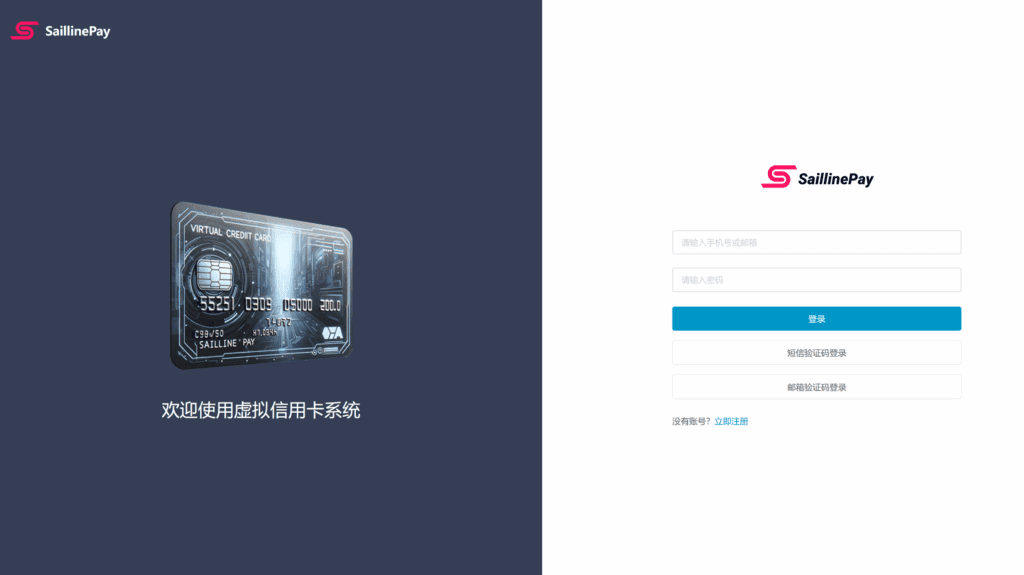At a time when cross-border trade and digital business is booming, efficient and secure payment tools have become the immediate needs of foreign trade and cross-border industry practitioners. Recently, I have paid attention to Saillinepay, a virtual card payment platform launched by Voyage Intelligence in April 2023, which has shown certain advantages in multi-scene payment, card segment coverage and compliance management, and is analyzed below in the context of practical application scenarios.
Website: https://saillinepay.com/login

I. Basic functions and core advantages of the platform
(i) Registration and accreditation mechanisms
The platform adopts an invitation-based registration model (2025 opens up self-registration), which requires contacting the channel manager via WeChat to obtain a one-time registration link, a design aimed at filtering out high-risk users. Registration is subject to three core conditions: first, Chinese resident status and completion of face real-name authentication (relying on Alipay's third-party system); second, the binding of mainland China cell phone numbers (support for code verification, eliminating disposable numbers); and third, the provision of a valid email address to receive notifications. Although the whole set of processes requires manual review, it guarantees the quality of users from the source and reduces the risk of abuse.
(ii) Multi-card segment coverage capability
Currently, the platform has access to 28 card segments, mainly in the United States (e.g., 486695, 559292 and other 22 BINs) and Hong Kong (e.g., 493193, 438357 and other 4 BINs), and the dynamic update mechanism of the card segments can be adapted to market changes. Users can verify the card attribution by themselves through tools such as "BINCHECKER", which enhances transparency and autonomy.
(iii) Adaptability to multiple scenarios
According to the feedback of actual application, the platform card segment has outstanding performance in the following areas:
- Cross-border e-commerce operation: Supports store rent payments on major platforms such as Amazon, Etsy, Shopify, and daily operational overhead on platforms such as Sizzle, LAZADA, and more.
- Consumption of digital services: Covering high-frequency scenarios such as Google ads, Facebook marketing, ChatGPT Plus subscription, and especially good compatibility in subscription services such as MidJourney and Youtube Prime.
- Overseas Living Services: It can be used for recharging overseas phone cards such as Ultra Mobile PayGo and Optus Australia Card, as well as basic services such as Godaddy hosting domain name purchase.
II. Cost structure and risk management
(i) Transparent rate system
The platform fee consists of a card opening fee, a top-up fee, and a transaction service fee:
- The card opening fee is fixed at $2 per card;
- USD Wallet top-up fee 2% (Alipay online top-up will bear additional 1% fee, total rate 3%);
- Card recharge service fee of 2%;
- For cross-border transactions, seven card segments, including 556167, are exempt from handling fees, while the remaining card segments are charged at "US$0.5 + 1% transaction amount".
(ii) Risk control measures
In order to curb irregular use, the platform has implemented a stepped payment failure handling fee: when the rejection rate is lower than 15%, it will be charged at "$0.15 + 1% failure amount"; when it is higher than 15%, it will be raised to "$0.5 + 1% failure amount". The charge will be raised to "$0.5+1%" if it is above 15%. At the same time, differentiated handling fees are set for low-value spending (e.g., US$0.6/transaction for transactions below US$50 in the 491724 card segment) to guide users to standardize the use of their cards.
Operation Guidelines and Precautions
(i) Registration and recharge process
Users need to complete the registration through the recommended link, and after real-name authentication, they can choose Alipay/WeChat transfer (15-minute audit to account, rate 2%) or USDT recharge (closed). It is worth noting that USDT transfer to USD wallet needs to pay an additional 1% floating rate, it is recommended to prioritize the use of fiat currency channels.
(ii) Card creation and management
After recharging, you can create your own cards in the "Card Management" module, which supports batch card opening and note management. The new "Application Scenario Query" function allows you to enter keywords (such as "ChatGPT") to get the recommended card segments, which reduces testing costs. After creation, card information (card number, CVV2, expiration date, etc.) can be viewed in real time in "Card Inquiry".
(iii) Common causes of failure and responses
Payment failure may be caused by the following factors:
- Balance and exchange rate error: Adequate balance should be reserved for non-USD transactions (it is recommended to pre-deposit 5% based on Baidu's exchange rate);
- Network Environment LimitationsSome platforms prohibit public proxy IPs, so you need to configure an exclusive IP or circumvent proxy detection;
- Area and Scene Limitations: If ChatGPT has restrictions on China-Hong Kong card segments, you need to confirm the card segment acceptance range of the target platform in advance;
- MCC Code DisableIf you encounter "MCC Error", you need to contact the platform to confirm whether the card segment supports the current transaction type.
IV. Applicable Groups and Compliance Tips
The platform explicitly restricts "three high" users with "high refusal, high refund and high verification", and is strictly prohibited to be used in sensitive areas such as Steam, AWS (in some scenarios) and Wechat payment. It is recommended that foreign trade enterprises, cross-border e-commerce sellers and users of compliant digital services prioritize and ensure that the transaction scenarios are in line with platform rules and local laws and regulations before use.
Overall, Saillinepay strikes a good balance between compliance, scenario coverage and cost control, making it suitable for practitioners who need high-frequency cross-border micropayments. Its dynamic card segment update mechanism and risk control measures provide a relatively robust virtual card solution for the industry. In actual use, it is recommended to test the adapted card segments with the business characteristics and maintain communication with the platform channel manager to obtain the latest policy support.











